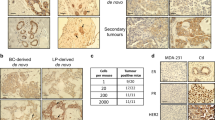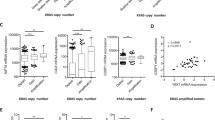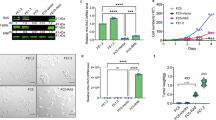Abstract
To identify genes associated with the resistance of Copenhagen (Cop) rats to mammary carcinogenesis, we infused a retrovirus harboring v-Ha-ras directly into the main mammary ducts of resistant F1 rats from a cross between Cop and susceptible Wistar Furth (WF) rats. Adenocarcinomas formed in approximately 50% of infused glands. Cell lines derived from these tumors were clonal, but did not share a common viral integration site, suggesting that a high level of v-Ha-ras expression was able to overcome resistance in the F1 rats. Some of the cell lines were able to grow in soft agar, but a significant number did not display anchorage-independent growth. These growth characteristics were independent of v-Ha-ras expression levels. The ability to grow in soft agar was associated with the size of tumors induced by injecting the cells into nude mice, and showed a striking positive association with the expression of cyclin D1. Furthermore, while resistance to anchorage-independent growth was fully overcome by transfection of cyclin D1 in some clones, in the others the effect was partial. A similar pattern of cyclin D1 upregulation and growth in soft agar was also observed when the cells were transfected with an active form of β-catenin. Hybrid cells from the somatic fusion of an anchorage-dependent to an anchorage-independent clone did not grow in soft agar. These results suggest that while a high expression level of cyclin D1 is necessary for anchorage-independent growth in all clones, it is not sufficient for full growth capacity in soft agar, raising the possibility that the loss of a tumor suppressor gene in the cell lines is required to fully confer anchorage-independent growth. Our anchorage-dependent and -independent rat mammary tumor-derived cell lines may recapitulate the resistance and susceptibility of Cop and WF rats, respectively, to mammary carcinogenesis that could facilitate the identification of breast cancer susceptibility genes.
This is a preview of subscription content, access via your institution
Access options
Subscribe to this journal
Receive 50 print issues and online access
$259.00 per year
only $5.18 per issue
Buy this article
- Purchase on Springer Link
- Instant access to full article PDF
Prices may be subject to local taxes which are calculated during checkout







Similar content being viewed by others
References
Bani MR, Rak J, Adachi D, Wiltshire R, Trent JM, Kerbel RS and Ben-David Y . (1996). Cancer Res., 56, 3075–3086.
Behrens J, von Kries JP, Kuhl M, Bruhn L, Wedlich D, Grosschedl R and Birchmeier W . (1996). Nature, 382, 638–642.
Ben-David Y, Giddens EB and Bernstein A . (1990a). Proc. Natl. Acad. Sci. USA, 87, 1332–1336.
Ben-David Y, Lavigueur A, Cheong GY and Bernstein A . (1990b). N. Biol., 2, 1015–1023.
Bestwick RK, Hankins WD and Kabat D . (1985). J. Virol., 56, 660–664.
Espada J, Perez-Moreno M, Braga VM, Rodriguez-Viciana P and Cano A . (1999). J. Cell Biol., 146, 967–980.
Filmus J, Robles AI, Shi W, Wong MJ, Colombo LL and Conti CJ . (1994). Oncogene, 9, 3627–3633.
Frisch SM and Francis H . (1994). J. Cell Biol., 124, 619–626.
Gould MN, Wang B and Moore CJ . (1989). Genes and Signal Transduction in Multistage Carcinogenesis, Colbrun NH (ed). Marcel Dekker: New York, pp. 19–38.
Han EK, Sgambato A, Jiang W, Zhang YJ, Santella RM, Doki Y, Cacace AM, Schieren I and Weinstein IB . (1995). Oncogene, 10, 953–961.
Jiang W, Kahn SM, Zhou P, Zhang Y, Cacace AM, Infante A, Doi S, Santella RM and Weinstein IB . (1993). Oncogene, 8, 3447–3457.
Korkola JE and Archer MC . (1999). Carcinogenesis, 20, 221–227.
Korkola JE, Wood GA and Archer MC . (1999). Breast Cancer Res., 1, 88–94.
Lin SY, Xia W, Wang JC, Kwong KY, Spohn B, Wen Y, Pestell RG and Hung MC . (2000). Proc. Natl. Acad. Sci. USA, 97, 4262–4266.
Markowitz D, Goff S and Bank A . (1988). J. Virol., 62, 1120–1124.
Michaelson JS and Leder P . (2001). Oncogene, 20, 5093–5099.
Miller JR and Moon RT . (1996). Genes Dev., 10, 2527–2539.
Morin PJ, Sparks AB, Korinek V, Barker N, Clevers H, Vogelstein B and Kinzler KW . (1997). Science, 275, 1787–1790.
Peters G . (1990). Cell Growth Differ., 1, 503–510.
Polakis P . (1999). Curr. Opin. Genet. Dev., 9, 15–21.
Price JE, Polyzos A, Zhang RD and Daniels LM . (1990). Cancer Res., 50, 717–721.
Quaroni A and Isselbacher KJ . (1981). J. Natl. Cancer Inst., 67, 1353–1362.
Rak J, Mitsuhashi Y, Erdos V, Huang S-N and Kerbel RS . (1995). J. Cell Biol., 131, 1587–1598.
Rosen K, Rak J, Leung T, Dean NM, Kerbel RS and Filmus J . (2000). J. Cell Biol., 149, 447–456.
Rudland PS, Paterson FC, Monaghan P, Davies AC and Warburton MJ . (1986). Dev. Biol., 113, 388–405.
Russo J and Russo IH . (2000). J. Mammary Gland. Biol. Neoplasia, 5, 187–200.
Shepel LA, Lan H, Haag JD, Brasic GM, Gheen ME, Simon JS, Hoff P, Newton MA and Gould MN . (1998). Genetics, 149, 289–299.
Shtutman M, Zhurinsky J, Simcha I, Albanese C, D'Amico M, Pestell R and Ben-Ze'ev A . (1999). Proc. Natl. Acad. Sci. USA, 96, 5522–5527.
Sukumar S, Notario V, Martin-Zanca D and Barbacid M . (1983). Nature, 306, 658–661.
Teodori L, Tagliaferri F, Stipa F, Valente MG, Coletti D, Manganelli A, Guglielmi M, D'Angelo LS, Schafer H and Gohde W . (2000). In Vitro Cell Dev. Biol. Anim., 36, 153–162.
Tetsu O and McCormick F . (1999). Nature, 398, 422–426.
Wang B, Kennan WS, Yasukawa-Barnes J, Lindstrom MJ and Gould MN . (1991). Cancer Res., 51, 5298–5303.
Willert K and Nusse R . (1998). Curr. Opin. Genet. Dev., 8, 95–102.
Wood GA, Korkola JE and Archer MC . (2002). Carcinogenesis, 23, 1–9.
Wisdom R, Johnson RS and Moore C . (1999). EMBO J., 18, 188–189.
Zhou Q, Hopp T, Fuqua SAW and Steeg PS . (2001). Cancer Lett., 162, 3–17.
Zhou Q, Wulfkuhle J, Ouatas T, Fukushima P, Stetler-Stevenson M, Miller FR and Steeg PS . (2000). Breast Cancer Res. Treat., 59, 27–39.
Acknowledgements
We thank Dr B Vogelstein for the β-catenin plasmid and Dr IB Weinstein for the cyclin D1 plasmid. We also thank Drs J Filmus and Kirill Rosen for their constructive comments on the manuscript and Robin Duncan for help with the experiments with nude mice. This work was supported by a grant from the Canadian Breast Cancer Research Initiative.
Author information
Authors and Affiliations
Corresponding author
Rights and permissions
About this article
Cite this article
Li, YJ., Song, R., Korkola, J. et al. Cyclin D1 is necessary but not sufficient for anchorage-independent growth of rat mammary tumor cells and is associated with resistance of the Copenhagen rat to mammary carcinogenesis. Oncogene 22, 3452–3462 (2003). https://doi.org/10.1038/sj.onc.1206411
Received:
Revised:
Accepted:
Published:
Issue Date:
DOI: https://doi.org/10.1038/sj.onc.1206411
Keywords
This article is cited by
-
A critical ETV4/Twist1/Vimentin axis in Ha-RAS-induced aggressive breast cancer
Cancer Gene Therapy (2022)
-
Induced mammary cancer in rat models: pathogenesis, genetics, and relevance to female breast cancer
Journal of Mammary Gland Biology and Neoplasia (2022)
-
Coactosin-like protein CLP/Cotl1 suppresses breast cancer growth through activation of IL-24/PERP and inhibition of non-canonical TGFβ signaling
Oncogene (2018)
-
PPAR-delta promotes survival of breast cancer cells in harsh metabolic conditions
Oncogenesis (2016)
-
Down-regulation of c-Myc following MEK/ERK inhibition halts the expression of malignant phenotype in rhabdomyosarcoma and in non muscle-derived human tumors
Molecular Cancer (2006)



